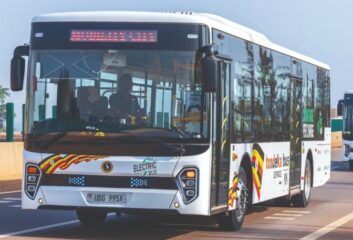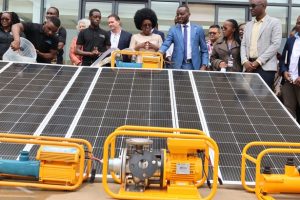By: Nakimuli Thatcher
Uganda, a nation known for its rich biodiversity, natural resources and stunning landscapes, is now poised to lead the charge in sustainable innovative transportation solutions. In an era where climate change and sustainability are crucial considerations, the country’s National E-Mobility Strategy, a collaborative effort across multiple sectors, aims to turn Uganda’s tide from being a consumer of E-Mobility solutions to becoming a source of innovative products and services. The overall strategy is to position Uganda as a net source, rather than a consumer, of e-mobility solutions.
The development of Uganda’s National E-Mobility Strategy involved a diverse group of stakeholders, including government bodies, research institutions, and industry players. Together, they crafted a forward-looking vision: A complete transition to e-mobility in public transport and motorcycles by 2030. This aligns with Uganda’s broader development goals outlined in the National Development Plan III and Vision 2040.
Globally, the mobility industry is a behemoth, valued at a staggering USD 15 trillion in 2017. By 2030, it is projected to grow to over USD 26.6 trillion. However, mobility also contributes significantly to greenhouse gas emissions. In Africa, it currently accounts for 10% of the total emissions. As sub-Saharan Africa’s vehicle market expands—from 25 million vehicles in 2021 to over 58 million by 2040, the need for sustainable alternatives becomes urgent.
In Uganda, urban transport heavily relies on two-wheeler boda-bodas (motorcycles), and sixteen-year-old used 14-seater Matatus (repurposed cargo vans). Their numbers have surged, but challenges persist—high energy costs, maintenance expenses, minimal product safety and quality; and limited ownership rates, are ubiquitous. E-mobility for public transport offers a non-polluting, efficient, and cost-effective solution. His Excellency the President of The Republic of Uganda, Yoweri Kaguta Museveni, has emphatically reasoned that shifting from petrol to electric vehicles is the most sustainable way forward! In line with this vision, Uganda aims to fully transition to electric vehicles in the next 20 years.
- E-Mobility: A Green Revolution
Enter E-Mobility—a game-changer in the fight against climate change. E-Mobility refers to the use of electric vehicles (EVs) powered by batteries or hydrogen fuel cells. Globally, the associated market is projected to skyrocket from USD 280 billion in 2021 to a whopping USD 1.5 trillion by 2028, growing at a Compound Annual Growth Rate of 27.2%.
E-Mobility, also termed Electric or Electro Mobility, refers to clean and efficient transport, using electric vehicles, powered either by batteries or hydrogen fuel cells and includes full electric vehicles, plug-in hybrid electric vehicles, as well as hydrogen fuel cell vehicles that convert hydrogen into electricity. E-Mobility includes light-duty automobiles, medium- and heavy-duty electric vehicles, electric micro mobility devices, and transit vehicles. The correct way to sustainably address the current fuel crisis in Uganda is to move from petrol to electric cars, buses, motorcycles, and trains.
Figure 1: Electric Vehicle Powertrains
Uganda’s National E-Mobility Strategy, driven by the Science, Technology, and Innovation Secretariat (STI) – Office of the President, along with key ministries and stakeholders, is aimed at harnessing this growth to create sustainable solutions for transportation while contributing to the reduction of greenhouse gas emissions, and promoting domestic value addition through utilisation of the country’s resources.
- Anticipated Benefits: The adoption of E-Mobility is envisioned to facilitate the qualitative leap of Uganda’s economy and social fabric.
By embracing E-Mobility, Uganda shall contribute to its Nationally Determined Contributions (NDCs), reduce its carbon footprint by up to 25% by 2040. Moreover, Uganda’s dependence on fuel imports and fossil fuels in general will be reduced as we shift towards cleaner energy solutions provided by E-Mobility. The premise of cleaner air and quieter streets presented by EVs is a benefit to public health. Research has shown that even at low penetration rates, EV uptake results in better air quality and reduced asthma-related emergency room visits. Uganda can negate its high burden of respiratory diseases and decrease the over 13,000 deaths attributed to air pollution annually.
Across the value chain, from R&D, product development, manufacturing through to sales and maintenance, new skills will be needed to support the rollout of EVs.
For the vehicle owners and operators, EVs have been proven to have lower maintenance and operational costs. The total cost of ownership of an Electric Vehicle (purchase price, maintenance, and operation costs) is 60% of that of the diesel equivalent. The cost of energy is 20-22% of the petrol or diesel equivalent. However, the initial purchase cost of acquisition is still much higher compared to the equivalent petrol and diesel vehicles. EV technology is evolving, however, and it is anticipated that as uptake increases and new technologies in batteries emerge, the purchase cost for EVs shall rapidly decline.
- Challenges or Barriers to E-Mobility: Adoption of E-Mobility is not without its challenges.
Uganda faces hurdles related to policy alignment, standards, and regulations for EVs and related technology and must craft strategic frameworks to promote its ambitions of domestic manufacturing. Energy Access and Reliability must transcend the Greater Kampala Metropolitan Area (GKMA) and other urban centres to proliferate rural areas and fast track countrywide adoption.
Increasing E-Mobility Adoption faces a chicken or egg dilemma. If the chicken was the electric vehicle and the egg was the charging infrastructure, the question would be, which do we develop first? This dilemma must be addressed if we Ugandans are to alleviate the range anxiety in the EV market. Government and private sector must plan cohesively to create reliable public charging points and fast charging stations across the nation to catalyse the growth of EVs and reduction in EV Prices.
- Uganda’s Sustainable E-Mobility Ecosystem
The STI Secretariat has organized the e-mobility ecosystem into six well-coordinated clusters to achieve the goal of the E-Mobility Strategy. These clusters encompass Research & Development (R&D), Engineering and Manufacturing, Energy, Transport Planning, Value Chain Financing, Policy and Regulations, and Digital Infrastructure. This holistic approach is designed to ensure Uganda’s success in the e-mobility sector.
Figure 2: E-Mobility Ecosystem Players in Uganda
- Early Success and Ambitions
The concerted efforts of both the government and the private sector have borne fruit. Uganda has developed and built over 1,600 Electric Vehicles including motorcycles, buses and bicycles. The nation currently has over 2,000 EVs in operation and this number is anticipated to grow with the increasing government incentives on EVs.
- Kayoola EVS Electric Buses: twenty-seven (25) Kayoola EVS electric buses, two (2) Kayoola Electric Coaches have been produced by Kiira Motors Corporation and now ply Ugandan Roads. These zero-emission vehicles are supported by a network of sixteen (16) fast chargers.
- Electric Motorcycles: Over 1,550 electric motorcycles cruise Uganda’s roads, backed by more than 100 battery swapping stations implemented by key players led by GOGO Electric, Zembo Motorcycles and Spiro.
- Supply Chain Localization: Local companies are stepping up. They’re involved in manufacturing critical vehicle components, including lithium-ion batteries, electronics, tires, and automotive paints.
Figure 3: The 10m Kayoola EVS City Electric Bus (200km Range)
Figure 4: Gogo EV-150 electric Motorcycle (120 km Range)
Figure 5: Zembo’s Thunder Electric Motorcycle (80km Range)
Figure 6: Spiro VEO Electric Motorcycle (78km Range)
- Uganda’s E-Mobility Roadmap: Accelerating Toward a Sustainable Future
A robust, self-sustaining, and competitive E-Mobility Ecosystem shall be established within Uganda’s borders with the following key objectives:
- Local EV Manufacturing & Supply: Uganda aims to boost local manufacturing and supply of electric buses, motorcycles, passenger vehicles and associated vehicle components. By nurturing domestic production, Uganda can create jobs, enhance self-reliance, and contribute to global sustainability;
- Local EV Battery Manufacturing: Government shall promote the local production of electric vehicle batteries and battery energy storage systems. Homegrown battery manufacturing reduces dependence on imports and strengthens Uganda’s industrial base;
- Electrifying Public Transport: The Strategy aims to transform public transport systems by adopting electric buses, motorcycles, and trains. This shall achieve cleaner air, reduced noise pollution, reduced traffic congestion and improved urban mobility;
- Charging Network Expansion: Government and Private Sector shall establish a robust charging infrastructure for electric vehicles. From battery swapping, plug-in to contact charging and wireless options, Uganda aims to cater to all emerging charging technologies to address the chicken-egg dilemma;
- E-Mobility Human Capital Development: This seeks to cultivate local skills and capabilities across the E-Mobility value chain. Training and education will empower Ugandans to lead the charge in E-Mobility;
- Boosting Electric Vehicle Uptake: The objective is to increase the adoption of electric vehicles, including electrifying the government fleet. The government’s commitment through leadership by example sets the tone for private sector participation;
- Setting Standards for Excellence: Government shall develop robust standards, regulations, guidelines, and a Code of Practice for the E-Mobility industry. Standards ensure quality, safety, interoperability, and reliability.
To ensure the success of the strategy, the government has outlined a series of supportive policy measures. These include tax exemptions for mobility research and development, fiscal incentives for manufacturers, incentives for electric vehicle users. Infrastructural measures, such as the installation of intra-city and inter-city charging points, are also part of the plan. For the Financial Year 2024/25, the government has already approved a series on tax incentives for E-mobility including:
- VAT exemption on domestic EV, EV Charging Equipment and EV Component Manufacturing
- VAT exemption on purchase of EVs made in Uganda
- VAT exemption on the supply of EV Chargin Equipment and/or EV Charging Services
- VAT exemption for manufacturers using at least 70% of locally produced raw materials and employing at least 70% Ugandans earning an aggregate wage of at least 70% of the total wage bill.
With these comprehensive measures in place, Uganda anticipates significant benefits. The strategy is expected to contribute 12.5% to the national GDP, create over 500,000 green jobs, and reduce transport-based emissions by over 25% by 2040. Additionally, it will generate over USD 15 billion in annual revenues and reduce transport-based emissions by over 2 MtCO2e by 2030.
The Government of Uganda commits to implementing these interventions and policy measures over the next 10 years. After this period, they will be reviewed, recalibrated, and adapted to keep pace with the dynamic E-Mobility landscape.
- A New Era for Uganda
Uganda’s journey toward E-Mobility is not just about vehicles; it’s about shaping a sustainable future. Uganda’s National E-Mobility Strategy represents a transformative shift in transportation and energy consumption. By leveraging a collaborative approach, the country aims to lead the way in E-Mobility innovation, creating a sustainable and thriving ecosystem for the future. The journey ahead is ambitious, but with a clear vision and a well-defined strategy, Uganda is poised to become a trailblazer in the E-Mobility landscape.







